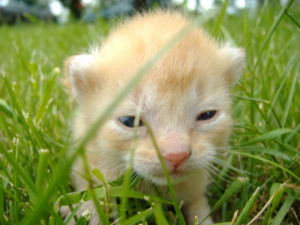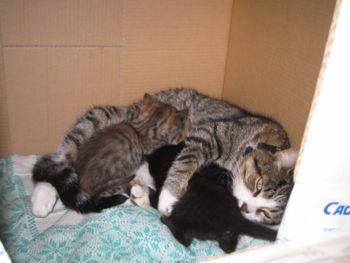Cat/Choosing a cat: Difference between revisions
imported>James F. Perry (→Finding the right match for you: things to avoid) |
imported>James F. Perry (→Finding the right match for you: start on section) |
||
| Line 5: | Line 5: | ||
==Finding the right match for you== | ==Finding the right match for you== | ||
Given a good, loving home and proper veterinary care, it is not at all unusual for cats these days to live to be 15 years of age or more. Thus, a prospective cat owner can expect that the new companion animal may well be a part of his/her life for many years. This alone is reason to carefully consider the acquisition of a new cat. | |||
===Your reason for wanting a cat=== | ===Your reason for wanting a cat=== | ||
| Line 11: | Line 13: | ||
===The cost of cat ownership=== | ===The cost of cat ownership=== | ||
Included in the cost of cat ownership is not only the initial acquisition costs (most shelters will have an adoption fee), but ongoing veterinary care in addition to the daily maintenance requirements of food and litter. | |||
===Some things to avoid=== | ===Some things to avoid=== | ||
Revision as of 18:45, 9 February 2007
Choosing a cat for a pet Most cats are of a varied genetic background and are divided simply into either 'domestic shorthairs', the most common cat in almost all parts of the world, and 'domestic longhairs'.
There are a number of fully established purebed breeds of cat, in which a cat or kitten is not only of a recognizeable sort but comes with registration papers from cat fancy organization. Despite the fact that the great majority of cats that are "homed" as companions are mixedbreed rather than pedigreed, the average mixbreed cat does vary in appearance somewhat throughout the world.
Finding the right match for you
Given a good, loving home and proper veterinary care, it is not at all unusual for cats these days to live to be 15 years of age or more. Thus, a prospective cat owner can expect that the new companion animal may well be a part of his/her life for many years. This alone is reason to carefully consider the acquisition of a new cat.
Your reason for wanting a cat
How much time will cat ownership require
The cost of cat ownership
Included in the cost of cat ownership is not only the initial acquisition costs (most shelters will have an adoption fee), but ongoing veterinary care in addition to the daily maintenance requirements of food and litter.
Some things to avoid
- choosing on impulse
- selecting a new companion animal by what the cat looks like
- selecting an animal as a gift for someone else
Which type of cat?
Pedigree or non-pedigree
Male or female?
When cats are 'left entire', that is- not surgically sterilized, there are very distinct differences between owning a male, rather than a female, cat. Those differences have to do with the consequences of reproduction.
Unneutered females
Unneutered female kittens become sexually mature somewhere between about six months and three years of age. Almost all mixedbreed kittens will be capable of mating and becoming pregnant with their first litter of kittens by the age of one year. The 'late developers' who do not usually breed until two or more years of age are restricted to certain purebred varieties (usually larger cats, like the Maine Coon). Therefore, anyone who chooses a female cat or kitten for a pet and also chooses to maintain it with the ability to breed will probably not have just a single cat for very long. There will be many kittens, and then cats, in short order.
When cat owners live in regions where kittens are wanted and good homes can be found for them, allowing a female cat to have a litter or two of kittens is sometimes done quite responsibly. Adopting such a kitten from a neighbor is a time-honored way of obtaining a cat. The consequences to the mother cat were few at one time, but nowadays there are a number of diseases that she is subject to catching if allowed contact with local tomcats. In most regions of the world, the number of unwanted cats and kittens is so high that animal experts strongly discourage this practice.
Can't a female simply be kept away from males and, in that way, remain kittenless? Yes, that can be done, but grown females who are not neutered and who are kept from mating are usually unpleasant pets to keep company with, and show every indication of being in discomfort. Further, they are at high risk for diseases of the reproductive organs. (see Cat XXX)
Such cats come into "heat" every few weeks, and when they do, they spray urine over their environment and, almost always, yowl, roll, and posture nearly constantly until they successfully attract a mate. Once a female cat becomes pregnant she will return to her normal behavior until the kittens are born, however many will have another period of estrus while nursing that litter. A unneutered female cat is easily capable of producing between 4 and 18 kittens annually.
Unneutered males
An entire male also sprays urine as a means of attracting a mate, and as a marker for his territory. The odor of an unneutered tom cat's urine is very different from that of a neutered tom's, it is extraordinarily pungent. The litter box used by a fertile tomcat is not tolerated in most homes. Some entire Toms that are allowed access to both the outdoors and the household restrict their spraying to the outside. Others do not. When tomcats are not neutered until after sexual maturity, some continue the habit of spraying urine (including indoors) despite their changed hormonal balance.
When unneutered adult male cats are allowed outside, they normally dedicate a good deal of their time to prowling for females in estrus. When such a female is also outdoors, the entire neighborhood may becomes aware of a screeching, hissing, yowling, and moaning group of tomcats bent on doing each other bodily harm. Many of these toms incur bites, scratches and lacerations and return home with open wounds. These fights can also result in becoming infected with one of the fatal feline viruses.
For all these reasons, the best choice of a pet male cat is one that is neutered young enough (no more than a year of age, or so) to avoid these problems.
Neutered males & females
Now that the population of unwanted and homeless domestic cats is so large, there is general agreement that all responsible pet owners do neuter their cats. When discussing neutered animals, the debate over "male or female?" concerns more subtle considerations than those that apply to fertile ones.
There are individual variations in the personality of cats. The range of those characteristics among males overlaps that among females, and so there is probably no gender based recommendation that is firmly rooted in fact.
Cat or kitten?
How old a kitten?
Kittens are born . Their eyelids are sealed shut and only open during the second week of life. At that time, the color of the eye is blue in all kittens, and will change over the next few weeks as pigment is laid down. At about four weeks of age many kittens can successfully lap milk from a low saucer, but even if an individual kitten is able to maintain growth from feeding independantly it is still "better off" remaining with its mother and litter mates. That's because there is XXXX.
By 8 weeks of age kittens can receive their first immunizations and wormings.
Breeders of pedigreed cats most often refuse to sell kittens that are less than 8-12 weeks of age.
Socialization of kittens
How many cats to adopt?
Where to find a cat or kitten
Once you have made the decision to bring a cat into your home, and have made basic decisions about the type of cat you want (such as the choice between pedigree or non-pedigree, adult cat or kitten, and the sex of animal), there are a number of possibilities as to where to obtain your new friend.
Purchase from a breeder
If you have decided to acquire a pedigree cat for show or breeding, your best choice is a specialist breeder. This is also the most expensive option.
Buy from a pet store
A local humane society or shelter
The "cardboard box" approach
Many people have very fond memories of a pet cat (or, more usually, a kitten) which they picked out of a litter in response to a free kittens advertisement in a newspaper. Or perhaps they found their new pet when they encountered some children seated in front of a grocery store entrance with a large cardboard box filled with several kittens and, again, the free kittens sign.
It is not that uncommon for families with small children to allow their female adult cat to have a litter of kittens as a way of teaching their children about the reproductive and rearing process. Afterwards, they try to find homes for the newly born kittens, hence the free kittens signs.
This can be a very good way to acquire a new pet cat. But first make sure the new kitten is at least 6 to 8 weeks old, as explained above. One of the big advantages of this method (aside from the cost, or at least the cost of acquisition) is that you get to meet the mother cat and also see the environment in which the kittens were born and raised. The most important factor in the development of the cat's personality is the personality of the mother cat and the environment in which the kitten was bred.
Just remember, though, that free does not mean there will be no costs involved. Almost immediately, you will have to take the new kitten to a veterinarian for a check-up and initial shots. And it would not be a bad idea to take the cat on condition of a clean bill of health from this initial check-up!
Health Considerations: Feline viruses
Currently there are at least two problematic viruses passed through the free ranging cat populations of the world. One is so-called Cat AIDS, or Feline Immunodeficency Virus, and the other is the cat leukemia virus. The danger from these viruses is not to people, but to other cats. These viruses are fatal, eventually, but the animal can be infected with either (or both) for months or years before illness is apparent. This does mean that if a ketten or cat is adopted as a stray or from a shelter there is the possibility of that animal harboring one of these viruses, and passing it to other cats it then comes into close contact with, perhaps other cats in the home or neighborhood.
Further Reading
- Michael Pollard: The Complete Encyclopedia Of The Cat (Parragon Publishing. Bath. UK. 2005 ISBN 1-40544-388-X)
- Elaine Wexler-Mitchell, DVM, Guide to a Healthy Cat (Wiley Publishing, Hoboken, New Jersey, USA. ISBN 0-7645-4163-3)
Internet resources
- Happy Paws' list of adoptable cats and kittens in Australia
- Pet Rescue and Adoption: lists of rescue groups for domestic animals, including cats, in Canada
- Mettacats, a charity devoted to placing homeless cats and kittens in Singapore
- UK Animal Rescuers: a public posting site for available animals
- Petfinder.com: rescue groups and shelters. Searchable database of domestic animals that are available for adoption




